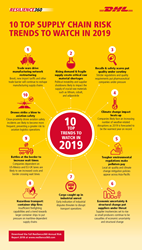Manufacturing Network Restructuring and Raw Material Shortages Among Top 10 Supply Chain Risk Predictions for 2019

Risk assessment and building up supply chain resilience is a crucial part of our customers’ business. Wherever they operate, the report’s insights will make the re-evaluation of the respective risk environment easier..,” says Tobias Larsson, CEO Resilience360.
WESTON, Fla. (PRWEB) March 27, 2019
DHL Resilience360 has released its first annual Risk Report. The report, based on risk and incident data collected by DHL’s cloud-based risk management system, Resilience360, examines last year’s major supply chain challenges and identifies trends that will shape the risk landscape in 2019: Companies may face additional costs and uncertainty due to raw material shortages, possibly more recalls and safety scares and increasingly tougher environmental regulations.
In a rapidly evolving supply chain risk environment, successful risk assessment is a significant challenge for companies in all sectors. The Resilience360 Annual Risk Report is based on the experience and insights of in-house analysts, who monitor hundreds of risk events each day. DHL experts help companies proactively manage disruptive events, from political violence to cargo theft, and minimize business interruption.
“The Resilience360 Annual Risk Report sums up our expertise to our customer’s benefit in a very comprehensive way. Risk assessment and building up supply chain resilience is a crucial part of our customers’ business. Wherever they operate, the report’s insights will make the re-evaluation of the respective risk environment easier and thus complement the existing Resilience360 offer,” says Tobias Larsson, CEO Resilience360.
Key supply chain disruptors in 2018
The first Resilience360 Annual Risk Report examines the major supply chain risks that companies experienced in 2018 including uncertainties concerning trade flows, cyber security incidents, and climate change paired with extreme weather conditions. Uncertainty in trade increased due to disputes between the US and other countries, in particular China, including new unilateral import tariffs. The still-open question of the UK’s withdrawal from the EU is also contributing to uncertainty, as companies fear border congestion and delays at ports in the event of a disorderly departure. In the realm of cyber security, a rising number of incidents involving supply chain and transport infrastructure showed how actors are intent on obtaining trade secrets, engaging in blackmail, or causing economic disruption. Lastly, climate change presented a myriad of severe weather-related disruptions in 2018, which was the fourth warmest year on record. Wildfires, droughts, low water levels and melting ice had the most significant impacts on supply chains.
Anticipating supply chain risks in 2019
The report also highlights an array of potential threats that could threaten businesses in 2019 and beyond. First, rising demand for raw materials, coupled with a fragile supply caused by political instability and supplier shutdowns, may result in raw material shortages for crucial materials such as lithium, cobalt, and adiponitrile. Second, recalls and safety scares may increase, as wider public awareness of quality issues and stricter enforcement by regulators in highly regulated sectors such as pharmaceuticals and medical devices subject products to higher scrutiny. Lastly, anti-pollution measures may be expanded in 2019 to a broader range of industries across Asia. The US Environmental Protection Agency is also expected to announce new requirements. As a result, tougher environmental regulations will increase costs for businesses in a number of industries. All of these developments have the potential to put suppliers under threat and force significant changes throughout supply chains.
“Modern supply chains are vulnerable. Transportation delays, theft, natural disasters, inclement weather, cyber-attacks and unexpected quality issues can disrupt cargo flows, creating short term costs and delivery challenges,” added Shehrina Kamal, Director Risk Intelligence, Resilience360. “Resilience360 strives to understand these risks and gain a common understanding of how they impact supply chains across countries, regions, industries and organizations in measurable ways.”
Major disruptors in United States, Canada and Mexico in 2018
The U.S., Canada and Mexico were affected by a large number of supply chain incidents due to the region’s position with approximately 28% of the world’s gross domestic product and as the No. 1 export and import partner for many countries worldwide. Civil unrest caused the most disruptions with 28% of incidents. Protest activities were directed against the Trump administration in the U.S. and tied to organized labor and the July 1 general elections in Mexico.
The overall number of natural disasters and weather-related incidents declined in 2018, but fires were a major concern. High-impact events included train accidents and derailment as well as earthquakes with severe consequences for supply chains. The number of cargo theft incidents in the US fell. Trade regulations and restrictions also affected supply chains. Trade negotiations between the US and Mexico, and then between the US and Canada, led to the United-States-Canada Agreement, or USMCA.
Detailed findings from 2018 and an overview of the coming challenges in 2019 are available in the full report which can be downloaded at http://www.resilience360.dhl.com.
About Resilience360
Resilience360 is an innovative, cloud-based platform that helps companies to visualize, track and protect their business operations. The solution facilitates intuitive supply chain visualization, tracks assets, suppliers, orders and shipments, and enables near real-time monitoring of incidents capable of disrupting or delaying supply chains.
- TEKLYNX Releases Enterprise Labeling Solutions TEKLYNX CENTRAL CFR 5.0 and TEKLYNX CENTRAL GHS 5.0
- Smartrac Supplies State-of-the-Art RFID Products that Fully Comply with the ‘Buy American’ Act
- AB&R’s ZC10L RFID large format card printer named finalist for Best New Product by RFID Journal #RFIDLive
- Marco Ehrhardt, EPG President and CEO, Named to the 2019 Rock Stars of the Supply Chain
- Vizinex Has Value-Added Systems Integrators Program at #RFIDLive
- Dual Frequency RFID Tags #RFIDLive
- New In-Mold Label With RAIN RFID #RFIDLive
- Hybrid Barcode & RFID Wearable Selected as Best New Product Finalist at the 13th Annual RFID Journal Awards #RFIDLive
